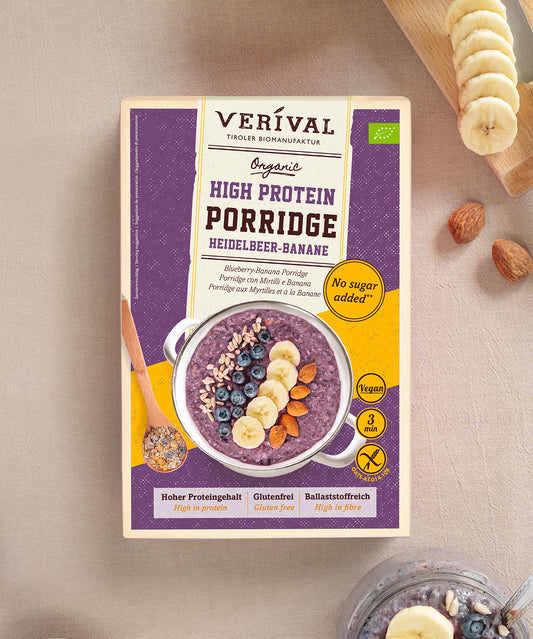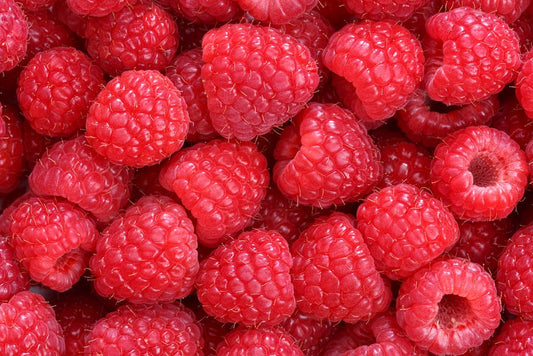The term “omega-3 fatty acids” has become much more widely known in recent years. Books have been written about them, omega-3 fatty acids are indicated on certain foods and sold as dietary supplements. And there is a very simple reason for this:
Omega-3 fatty acids are essential for the human body – that much we can already reveal.
In this article, we will show you why this is so, where they fit into the broad category of fats, which fat should be on your menu from now on, and how you can easily incorporate omega-3 fatty acids into your healthy breakfast.
Fat makes you fat: No!
Do you know this sentence: fat makes you fat? If so, then mentally take a thick red pen and cross this sentence out of your memory. The key is to evaluate the quality of fats and to choose the good fats that our body needs for metabolic processes. Omega-3 fatty acids, which are true all-rounders, are an especially underrated nutrient.
Verivals Omega-3-rich seed mix for your muesli
What are healthy fats?
There are different types of fats that can be categorized according to the quality of their structure. We distinguish between:
- monounsaturated and polyunsaturated fatty acids,
- saturated fatty acids and
- trans fatty acids
Omega-3 fatty acids are a type of polyunsaturated fatty acid.
How many calories are in fat?
What all fatty acids have in common is their calorific value. At 9 kcal/g, fat has the highest calorific value, which is why there are so many concerns about this nutrient. By comparison, carbohydrates and proteins only have a calorific value of just under 4 kcal/g.
If you eat a lot of fat, you run the risk of consuming more calories than you actually need. However, it must always be kept in mind that fat has a high degree of satiety, which is why 100g of salmon, for example, will keep you fuller for longer than 100g of cooked rice. So the amount and quality of the fat we consume is crucial.
Omega-3 fatty acids are essential for the body
In the field of nutritional science, the word essential means that a certain nutrient, such as omega-3 fat, is vital for the body. The paradox is that the body cannot produce these vital nutrients itself, which means that they must be supplied with food. But what exactly are omega-3 fats and why are they so important for the human body?
What are omega-3 fatty acids?
Omega-3 fats are a small group of polyunsaturated fatty acids that are essential for the body and must therefore be supplied through food.
We distinguish between the following types, which can be found in both animal and vegetable sources:
- EPA (eicosapentaenoic acid)
- DHA (docosahexaenoic acid)
- ALA (alpha-linolenic acid)
What are the effects of omega-3 fatty acids?
The important omega-3 fatty acids are the starting substance for the formation of various structures in the body. The following positive properties are attributed to this fat:
- Omega-3 fatty acids are part of our immune system because they have an anti-inflammatory effect. Therefore, it is recommended to increase the proportion of omega-3 fatty acids in the diet, especially for inflammatory diseases such as rheumatism.
- Omega fats can also improve blood lipids by raising HDL cholesterol and lowering triglycerides.
- They promote the formation of hormones.
- Omega-3 fatty acids also support blood supply and help maintain cell flexibility.
- Omega fats also have a particularly positive effect on brain performance.
Omega-3 fatty acids – brain food for improved performance
As already mentioned, another positive property of the important omega-3 fatty acids is their effect on the brain. Omega-3 fats are found in the neuronal membranes, where they ensure that stimuli are transmitted faster, i.e. impulses are transmitted faster at the synapses.
This is also the reason why walnuts, which contain a lot of omega-3 fatty acids, are often referred to as brain food, as they have a positive influence on our mental performance and ability. Yes, omega-3 fatty acids and walnuts have truly earned their positive reputation!
We have summarized how you can support your brain in our article “Brain food – healthy nutrition for our brain”.
How many omega-3 fatty acids are healthy per day?
Since omega-3 fatty acids are only found in selected foods, it is difficult to overdose. Rather, it is important to cover the minimum of 0.5% of your energy needs per day with omega-3 fatty acids. This corresponds to about 2-3 portions of fish per week. Since many people do not manage this, they resort to expensive dietary supplements, such as fish oil capsules. However, it is also possible to get an adequate supply of omega-3 fats by choosing the right foods.
Foods rich in omega-3
In nature, omega-3 fatty acids are found primarily in fish, seeds, nuts and vegetable oils. Linseed oil is particularly worthy of mention here, as it has the best utilization ratio in the body due to the 5:1 ratio between omega-3 and omega-6 fats. Other oils such as walnut, rapeseed or soybean oil are also sources of omega-3.
In the seed category, flaxseed and chia seeds are optimal omega-3 sources that can be added to muesli first thing in the morning, for example. Those who like to eat fish should include oily fish such as salmon, mackerel or tuna in their diet 2-3 times a week.
Omega-3 fatty acids in a vegan diet
A brief explanation of a vegan diet
Those who follow a vegan diet avoid all animal products in their diet. This includes rejecting meat, fish, eggs, milk and honey. Vegans often also avoid products such as sheep's wool or leather. However, those who follow a vegan diet need to pay a little more attention to their essential nutrients. For example, vitamin B12 and vitamin D should be added in the form of supplements in the case of a long-term vegan diet. Since omega-3 fatty acids are also an essential nutrient, we will show you where to find vegan omega-3 sources.
Where can I find vegan omega-3 sources?
Omega-3 fatty acids are found in nature not only in fish but also in plants. This is because plants use them for cold regulation, which is why algae, for example, also contain a large amount of omega-3 fats. One example is red algae, which also serves as a food source for many marine animals.
Other plant sources include all types of seeds, which can be used to top off your muesli or porridge. Hemp seeds, chia seeds, and vegetable oils are suitable sources of omega-3 in a vegan diet, as well as for those who eat an omnivorous diet.
If you want to try chia seeds, which have been so popular for a few years now, you can read all about how to prepare chia seeds and some of our favorite chia recipes here.
Conclusion: an overview of omega-3 fatty acids
Omega-3 fatty acids are a small group within the fats, more precisely they belong to the polyunsaturated fatty acids. Fats are by no means a nutrient that should be avoided. However, it depends on the right selection, quantity and quality. Since the body cannot produce some essential fatty acids itself, the intake of omega-3 fatty acids is very important. By consciously choosing omega-3-rich foods such as fish, algae, seeds, nuts and vegetable oils, it is quite possible to cover the daily requirement.
References:
- Literature sources: Biesalski H., Bischoff S., Puchstein C, Stuttgart 2010, Thieme-Verlag: Nutritional Medicine p.86 ff.
- https://www.dge.de/wissenschaft/referenzwerte/fett/
- https://www.smartfoodfacts.org/post/was-sind-omega-3-fettsauren
- https://fet-ev-eu/omega-3-fettsaeuren/
























